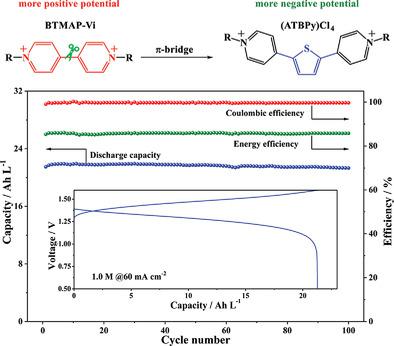当前位置:
X-MOL 学术
›
Adv. Funct. Mater.
›
论文详情
Our official English website, www.x-mol.net, welcomes your feedback! (Note: you will need to create a separate account there.)
Five-Membered-Heterocycle Bridged Viologen with High Voltage and Superior Stability for Flow Battery
Advanced Functional Materials ( IF 19.0 ) Pub Date : 2022-01-07 , DOI: 10.1002/adfm.202111744 Mingbao Huang 1 , Shuzhi Hu 1, 2 , Xianzhi Yuan 1 , Jinghua Huang 1 , Wenjin Li 1 , Zhipeng Xiang 1 , Zhiyong Fu 1 , Zhenxing Liang 1
Advanced Functional Materials ( IF 19.0 ) Pub Date : 2022-01-07 , DOI: 10.1002/adfm.202111744 Mingbao Huang 1 , Shuzhi Hu 1, 2 , Xianzhi Yuan 1 , Jinghua Huang 1 , Wenjin Li 1 , Zhipeng Xiang 1 , Zhiyong Fu 1 , Zhenxing Liang 1
Affiliation

|
Viologen and its derivatives have been widely investigated as the electroactive materials in aqueous flow batteries (AFBs). The high redox potential of viologen poses a challenge to the AFB's energy density when used as the negative electrolyte. A molecular engineering strategy is developed by inserting an electron-rich π-bridge unit (viz. thiophene, furan) between the two pyridiniums to lower the redox potential. The resultant 1,1′-bis[3-(trimethylamonium)propyl]-4,4′-(2,5-thiophenediyl)bispyridinium tetrachloride ((ATBPy)Cl4) and 1,1′-bis[3-(trimethylamonium)propyl]-4,4′-(2,5-furandiyl)bispyridinium tetrachloride ((AFBPy)Cl4) are investigated by a variety of physiochemical methods to track the structure of the molecule and its evolution during the electrochemical reaction. A flow battery is assembled to verify the applicability of (ATBPy)Cl4 with 1-(1-oxyl-2,2,6,6-tetramethylpiperidin-4-yl)-1′-(3-(trimethylammonio)propyl)-4,4′-bipyridinium trichloride as the positive electrolyte. Run at the concentration of 1.0 m, the battery achieves a standard cell voltage of 1.51 V, capacity of 23.6 Ah L–1, energy efficiency of 85.7% at 60 mA cm–2, and a record peak power density of 302 mW cm–2, which outperform the reported viologen-AFBs in literature. This work provides an effective strategy to develop electrochemically active compounds with tunable redox potential and superior chemical stability by molecule engineering.
中文翻译:

用于液流电池的具有高电压和优异稳定性的五元杂环桥接紫精
紫罗碱及其衍生物作为水流电池 (AFB) 中的电活性材料已被广泛研究。紫精的高氧化还原电位对 AFB 用作负极电解质时的能量密度提出了挑战。通过在两个吡啶鎓之间插入一个富含电子的 π 桥单元(即噻吩、呋喃)来降低氧化还原电位,开发了一种分子工程策略。生成的 1,1'-双[3-(三甲基铵)丙基]-4,4'-(2,5-噻吩二基)双吡啶鎓四氯化物 ((ATBPy)Cl 4 ) 和 1,1'-双[3-(三甲基铵) )丙基]-4,4'-(2,5-呋喃二基)双吡啶鎓四氯化物((AFBPy)Cl 4) 通过多种物理化学方法进行研究,以跟踪分子的结构及其在电化学反应过程中的演变。组装液流电池以验证 (ATBPy)Cl 4与 1-(1-oxyl-2,2,6,6-tetramethylpiperidin-4-yl)-1'-(3-(trimethylammonio)propyl)-的适用性4,4'-联吡啶三氯化物作为正极电解质。在 1.0 m浓度下运行,电池达到 1.51 V 的标准电池电压,23.6 Ah L -1的容量,60 mA cm -2时的能效为 85.7%,峰值功率密度达到 302 mW cm - 2,其性能优于文献中报道的紫精-AFB。这项工作为通过分子工程开发具有可调氧化还原电位和优异化学稳定性的电化学活性化合物提供了一种有效的策略。
更新日期:2022-01-07
中文翻译:

用于液流电池的具有高电压和优异稳定性的五元杂环桥接紫精
紫罗碱及其衍生物作为水流电池 (AFB) 中的电活性材料已被广泛研究。紫精的高氧化还原电位对 AFB 用作负极电解质时的能量密度提出了挑战。通过在两个吡啶鎓之间插入一个富含电子的 π 桥单元(即噻吩、呋喃)来降低氧化还原电位,开发了一种分子工程策略。生成的 1,1'-双[3-(三甲基铵)丙基]-4,4'-(2,5-噻吩二基)双吡啶鎓四氯化物 ((ATBPy)Cl 4 ) 和 1,1'-双[3-(三甲基铵) )丙基]-4,4'-(2,5-呋喃二基)双吡啶鎓四氯化物((AFBPy)Cl 4) 通过多种物理化学方法进行研究,以跟踪分子的结构及其在电化学反应过程中的演变。组装液流电池以验证 (ATBPy)Cl 4与 1-(1-oxyl-2,2,6,6-tetramethylpiperidin-4-yl)-1'-(3-(trimethylammonio)propyl)-的适用性4,4'-联吡啶三氯化物作为正极电解质。在 1.0 m浓度下运行,电池达到 1.51 V 的标准电池电压,23.6 Ah L -1的容量,60 mA cm -2时的能效为 85.7%,峰值功率密度达到 302 mW cm - 2,其性能优于文献中报道的紫精-AFB。这项工作为通过分子工程开发具有可调氧化还原电位和优异化学稳定性的电化学活性化合物提供了一种有效的策略。



























 京公网安备 11010802027423号
京公网安备 11010802027423号